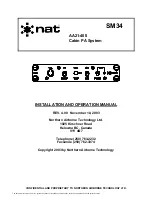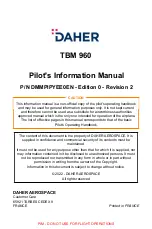
Stormscope
®
WX-1000 Pilot’s Guide
4-2
Chapter 4 – Weather Display Interpretation
monitored by the
WX-1000
. Areas of gray or black indicate
thunderstorms. The darker the area, the greater the rate of
electrical discharge activity.
Typical Patterns
Three Clusters within the 200 nmi Range Ring
Figure
4-2
shows the
360
° weather view at the
200
nmi range.
Using this knowledge, the outer range ring, and the azimuth
markers, the three clusters of discharge points on the screen
can be interpreted as representing three thunderstorm cells
at the following azimuth and range:
Cluster
Azimuth (clock position) Range
1
11:00
180 nmi
2
4:00
75 nmi
3
4:00
180 nmi
The screen can also tell us about the relative amount of
electrical discharge activity in thunderstorm cells. Clusters
2
and
3
have more discharge points than cluster 1 indicating
greater electrical discharge activity. All three clusters how-
ever must be avoided because you can’t necessarily deter-
mine the severity of thunderstorms based strictly on the
number of discharge points. For example, in the western
U
nited
S
tates, a severe thunderstorm may only have a few
electrical discharges.
When the range is changed to
100
nmi (figure
4-3
), only
cluster
2
remains visible. Clusters
1
and
3
are beyond the
100
nmi range and therefore no longer appear on the screen.
(Clusters
1
and
3
would again be visible if the range were
returned to
200
nmi.) Cluster
2
is now more defined and the
discharge points are larger. The interpretation of cluster
2
remains the same: a moderately active thunderstorm at
azimuth
4:00
, range
75
nmi.
Two Clusters within the 200 nmi Range Ring
Figure
4-4
shows the
screen in the
360
° weather view at the
200
nmi range. Using this knowledge, the outer range ring,
and the azimuth markers, the two clusters of discharge
points on the
screen can be interpreted as one thunderstorm
cell at
5:30
, about
150
nmi from the aircraft, and another cell
at
1:00
, about
100
nmi from the aircraft. The cluster at
1:00
Typical Patterns
































